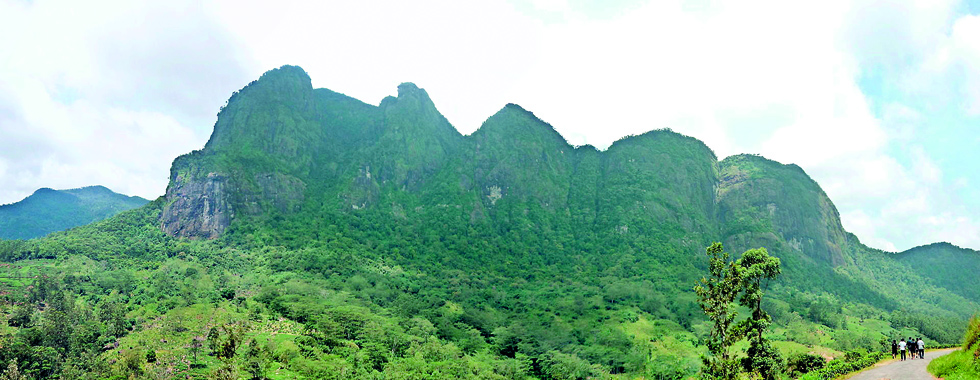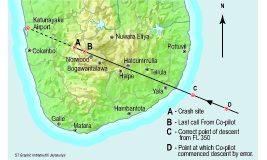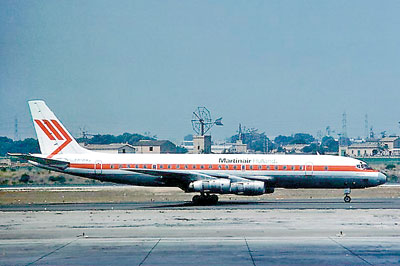Doomed flight
View(s):What really happened to Martinair MP-138 that plunged into the Seven Virgins Mountain Range in Maskeliya 40 years ago killing all 191 on board? Donald Rosa, the engineer who investigated the crash looks back
It was on December 4, 1974, that Martinair flight MP 138 crashed in the Seven Virgins mountain range killing the 182 passengers on board, on their way to Mecca together with nine crew.
The responsibility for conducting the investigation into any aircraft accident rests solely with the Directorate of Civil Aviation of the country of occurrence. Since the accident was within Sri Lankan airspace, the responsibility for the investigation rested with the Director of Civil Aviation, Sri Lanka. As head of the Airworthiness and Accident Investigation Division of the Department of Civil Aviation, Sri Lanka at that time, as well as being appointed as the Technical Representative on the Accident Investigating Committee, appointed by the Ministry of Transport and Aviation, I was responsible for carrying out the technical investigation and submitting the findings in the form of a Draft Report to the Accident Investigation Committee.
The Civil Aviation authorities of the country of registration of the aircraft, of the country of operation of the aircraft and of the country of manufacture of the aircraft were entitled to take part in the investigation and required to furnish all relevant information connected in any manner to the flight, to the Directorate of Civil Aviation (DCA) investigating team of the country of occurrence as per ICAO procedures .
Investigations at Site
The occurrence of an aircraft accident or incident within the air space of a country has to be reported immediately by the Air Traffic Control (ATC) to the Technical Division of the DCA, and it is their responsibility (in this instance, the Aeronautical Inspection Directorate of the Department of Civil Aviation, Sri Lanka) to proceed to the site as soon as possible.
The Technical Investigation Team (TIT) of the DCA was at the site on December 5, 1974 around 4.30 a.m. The team split up, with one undertaking the arduous task of scaling the mountains to the impact site, and the other remaining behind to record statements of witnesses. The first team was able to reach the impact area at an elevation of 4250 feet above mean sea level by 8.30 a.m.
 Initially, the debris pattern was noted and critical items of debris that could prove relevant to the investigation were collected and secured.
Initially, the debris pattern was noted and critical items of debris that could prove relevant to the investigation were collected and secured.
This proved a formidable task as a large number of civilians arriving at the site were collecting debris and other personal belongings of passengers, not heeding the team’s requests to refrain from disturbing the site and thereby destroying any available evidence. By noon, a special bus service had been started from Maskeliya and Hatton to the site for sightseers, thus swelling the crowds. With the arrival of the Army, the crowds were soon brought under control and dispersed and the site was declared a restricted area.
The Flight Data Recorder was found at the base of the 4th peak of the mountain range. Due to impact and fire, it had been severely damaged. A section of tape remaining intact measuring 130 ft. was recovered and secured to be sent subsequently for readout.
The rest of the Technical Investigation Team proceeded to record statements of eye witnesses. Statements of reliable eye witnesses to the flight of the aircraft prior to impact confirmed that there was no fire on board the aircraft before impact.
One witness claimed to have seen fire trailing the aircraft in flight ending up in a huge ball of fire on impact. On cross examination, he stated that he had been in bed at that time and had made these observations through the window alongside his bed. However, the window he pointed out to the team was on the opposite side of the house from the flight path of the aircraft and the flight path was not even remotely visible from the location he claimed he had been in at the time of impact.
Contrary to these claims, the boy employed at the Superintendent’s bungalow on Theberton Estate accurately recalled the lights he had seen on the aircraft shortly before impact. His description of the lights on the aircraft cabin area and the wing tips tallied with conventional aircraft lighting and the correct direction of flight of the aircraft. He further confirmed that there were no visible signs of a fire on board the aircraft prior to impact.
Follow up investigations
The aircraft PH-MBH, bearing registration number, owned by Martinair Holland N.V, was on the Netherlands register at the time of the accident. Manufactured by Mc.Donnel Douglas Corporation of USA in 1966, it bore the manufacturer’s serial number 45818. The aircraft was a model DC-8 55F powered by four Pratt & Whitney JT3D 3B engines. It was purchased by Martinair on September 21, 1973 from Seaboard World Airlines of USA.
At the time of the accident it had flown a total of 35,613 hours of which 3,347 hours was with Martinair. It possessed a certificate of airworthiness number L-2064, issued by the Netherlands Civil Aviation Authority, valid until 14th December 1975. Maintenance of the aircraft was contracted to KLM (as was the entire fleet of Martinair) It had a few peculiarities which are dealt with further on in this report.
Witness’ statements
Flight MP-138 had been cleared on Airway Red 61 from Surabaya in Indonesia, to Colombo. The flight would have crossed our shoreline at Yala and flown over Tellulla, Halpe, Haldummulla, Bogawantalawa and Norwood before it met with the accident. Statements were recorded from witnesses along the way in an attempt to detect any pre-crash failure or fire on board. All witnesses observed that there was nothing unusual except for the aircraft flying lower than usual when compared with other aircraft they had observed on this route.
Witnesses in Bogawantalawa and Norwood said the aircraft was observed as being dangerously low, its engine noise as a result being very loud when compared to what they observed normally.
Navigational Aids
All locations of Navigational Aids that may have had a bearing on the progress of the flight were visited and their logs checked to assess their functionality on the date of the accident. It was determined that the Navigational Aids had no relevance to the cause of the accident.
Flight Data Recorder
The recovered section of the Flight Data Recorder tape was sent to the NTSB of the United States for read out. After investigations the NTSB informed us that the portion of the tape sent to them was from the supply spool and had no information relevant to the flight in question. Hence the recovered tape failed to make any contribution to the investigation.
Communications between Air Crew, Area Control at Ratmalana and Approach Control of BIA
Recording facilities for all communications between flight crews and ATC staff are available at the Katunayake Airport. Tapes relevant to Flight MP 138 were initially secured and subsequently read out in the presence of the Civil Aviation authorities of the Netherlands and Indonesia. A transcript of the communications was made and a copy made available to TIT. The transcript proved of immense assistance. On perusal of the transcript by the Netherlands Investigating Team, they confirmed that the communications between the aircraft and the ATC had been carried out by the Co-pilot, Robert Blomsma which led to the conclusion that he was in control of the aircraft during this critical phase of the flight. TIT consequently focused on the operating crew.
Air crew
Perusal of the transcript revealed that the crew on this flight had not reported to ATC on the correct reporting points on this route, and at times used the incorrect frequency when communicating. Although this had been brought to the notice of the aircrew by ATC a few times, the crew continued communications in the same manner as before. It was unusual that Capt. Hendrik Lamme, had failed to correct Co-pilot Blomsma in these instances.
 On further follow-up, it transpired that Capt. Lamme had not flown the sector Surabaya / Colombo previously and his most recent flying experience in the Far East sector had been two months previous to this flight when he flew Abadan/Kuala Lumpur/Bangkok/Dubai as Co-pilot on a DC-8 aircraft.
On further follow-up, it transpired that Capt. Lamme had not flown the sector Surabaya / Colombo previously and his most recent flying experience in the Far East sector had been two months previous to this flight when he flew Abadan/Kuala Lumpur/Bangkok/Dubai as Co-pilot on a DC-8 aircraft.
Co-pilot Robert Blomsma had never flown the Far Eastern sector and this was his first flight on the sector Surabaya /Colombo. The lack of knowledge of the operating crew on this route and the failure of Martinair to provided route familiarization flights for crew (as is the normal practice of airlines) before deploying them on this operation was a major contributory factor in this accident.
From the information provided by the Netherlands DCA, Co-pilot Blomsma had had a disturbed childhood and on the day of the accident, he was awaiting a legal decision on a matter crucial to his personal life. This could have adversely affected his powers of concentration during the approach phase of a landing. The communication of Co-pilot Blomsma at 16.52.35 indicated that his salutation to ATC was ‘Good Morning’, when both GMT and local times were afternoon and evening. This indicated he was still using Indonesian time whereas he should have communicated using GMT which is the time used universally in aviation and mandatory in aviation circles in order to ensure standardization and air safety.
Crew fatigue
During the 24 hours preceding the accident, the crew had flown approximately five hours, well within the Flight Time Limitations laid down for safe operations. Hence crew fatigue has not been a contributory cause of the accident.
Navigational Aids on board PH-MBH
Further analysis of the transcript indicated that the reporting call outs made by Co-pilot Blomsma were always very specific indicating a digital display. This led TIT to investigate what probable navigational aid he was relying on to communicate aircraft positions to ATC. The applicable sections of the aircraft communications with Area Control maintained on Flight Progress Strips and the co-pilots communications with the Air Traffic Controllers extracted from the transcript are reproduced here:
Time (GMT/Local) Gist of communication
13.34/7.04 pm Reported over Bengkulen and gave estimated time of entry point to Colombo FIR (920E) as 1503. (692 nautical miles from Bengkulen, {the last reporting point in the Indonesian FIR}.)
14.57/8.27 pm Reported entry into Colombo FIR. (6 mts. Earlier than estimated time earlier)
15.57/9.27 pm Reported 850E over the sea, 467 nautical miles from FIR Boundary at 920E.
16.22/9.52 pm Reported 130 nautical miles out at altitude of 35000 ft. Aircraft contacted Colombo Control on HFRT
16.22.35/
9.52.35 pm Good Morning Sir, we are one three zero miles out – Flight level three five zero, three five zero.
16.38.48/
10.08.48 pm We are out of seven thousand for six thousand and we are one four miles out.
16.40.05/
10.10.05 pm

Martinair DC8 55F aircraft PH-MBH
Roger, we are cleared to two thousand feet one zero one zero four kilo alpha tango or field in sight.
Since this pointed to the air crew resorting to a single digital indicator in the cockpit, TIT looked into which instrument on the panel would give such an indication.
Doppler Distance to Go Indicator
From the information provided, it was identified as the ‘Distance To Go’ display of the Doppler Computer Indicator. Accordingly the Investigation Team requested the Directorate of Civil Aviation of the Netherlands to look into and provide maintenance records and history of the Doppler Computer Indication system on the Martinair aircraft PH-MBH for further investigations. The information provided by the DGCA Netherlands revealed some critical facts about this equipment.
The aircraft PH-MBH had been acquired by Martinair from Seaboard World Air Lines of USA in 1973, having flown a total of 32,266 hours at that time. Whilst operating in the Martinair fleet for approximately 3347 flying hours, it was taken in for standardization with the KLM fleet as maintenance of Martinair aircraft was carried out by KLM. It originally possessed a Bendix Doppler System, whereas the KLM standard Doppler equipment was Marconi Elliot. While the conversion of this equipment was in progress, PH-MBH had been taken out and deployed on the Haj Charter accurately, with the Doppler Distance To Go indicator ticking off too fast, indicating a shorter than the actual distance to go to the destination in the cockpit display.
The error had been noted in the Aircraft Operations Manual for the information of Air Crews operating this aircraft. Further, the AOM advised Air Crews not to use the Doppler for navigation on account of this deficiency. The final stage of the flight is reproduced in the map (on Page 1) demonstrating the premature descent initiated by the crew due to the error in the DDTI resulting in the collision with the Seven Virgins mountain range 46 miles from the Katunayake International Airport.
This led TIT to focus on possible alternate equipment on the PH-MBH instrument panel that would have enabled the flight crew to cross-check the accuracy of the DDTI.
The Weather Radar
The only other equipment on the panel that would have served as a possible cross-checking system was the Weather Radar. However the distances obtained by using this are not accurate, enabling the crew to approximately cross-check the DDTI reading as this only gave the crew an indication of a range within which the actual distance lies. This is possible when interpreting one’s distance from the Plan Position Indicator. The crew has to bear in mind the range selected on the display when such a cross-check is done. Unfortunately, the PPI on PH-MBH was off standard as well when compared with the PPI’s in the KLM standard fleet. The manner in which the two different PPI’s were configured is given in the chart below.
The chart shows clearly the disparity between the two PPI’s and the possibility of making an error in assessing the distances in this instance. It was therefore concluded that, assuming the crew had taken the initiative to cross-check the DDTI reading using the Weather Radar PPI, the chances of being misled by the peculiarity of the Weather Radar PPI on the PH-MBH was very high considering the fact that the crew were obviously not familiar with the peculiarities of the PH-MBH flight instrumentation.
Aircraft Operations Manual
Martinair representations before the investigation stated that instructions regarding the peculiarities of the Weather Radar PPI and non-functional DDTI were incorporated in the Aircraft Operations Manual (AOM) of PH-MBH, for the information of the crew by way of Yellow Pages. They further stated that the cockpit briefing card had made a note of these deficiencies. Neither of these documents was recovered at the site. Nor were copies of documentation to the effect that this action had been taken, which should have been available in Martinair records, submitted to the investigation for reference. Martinair stated that they had assigned specific crews to operate PH-MBH, who were briefed of these peculiarities.
Considering the fact that this crew was assigned to Flight MP138 that day, due to the rostered crew reporting sick at the last moment and this being the first flight on that sector of both the Captain and Co-pilot, the possibility of their having gone through the bulky documents like the AOM before take-off and noting these peculiarities was exceedingly remote.
Prior to the accident, Martinair had operated 55 flights on this sector, of which this was the 19th flight of PH-MBH on this operation. Unfortunately both Capt. Lamme and Co-pilot Blomsma were not familiar with the route, as this was their first flight on this sector and no route familiarization had been given to them prior to scheduling them as regular crew.
The investigation therefore concluded that a combination of all these unfortunate factors along with the crew relying solely on a defective DDGI had resulted in this accident.
(The writer is a Chartered Engineer and
former Deputy Director of Civil Aviation (Airworthiness & Accident Investigation))
| Final report: Contributed to aviation safetyConsequent to the investigation, the factors that led to this accident were clearly identified, so much so that the ICAO not only accepted the Accident Investigation Report submitted by the Directorate of Civil Aviation, Sri Lanka, but featured it in the ICAO Circular No. 132-AN/93, titled Aircraft Accident Digest No. 21 of 1978, as a report described as follows: “That the international dissemination of the information contained in the Final Report is of exceptional value to the promotion of aviation safety, because of the successful employment of new investigative techniques or the disclosure of the need for significant preventive action”. |


